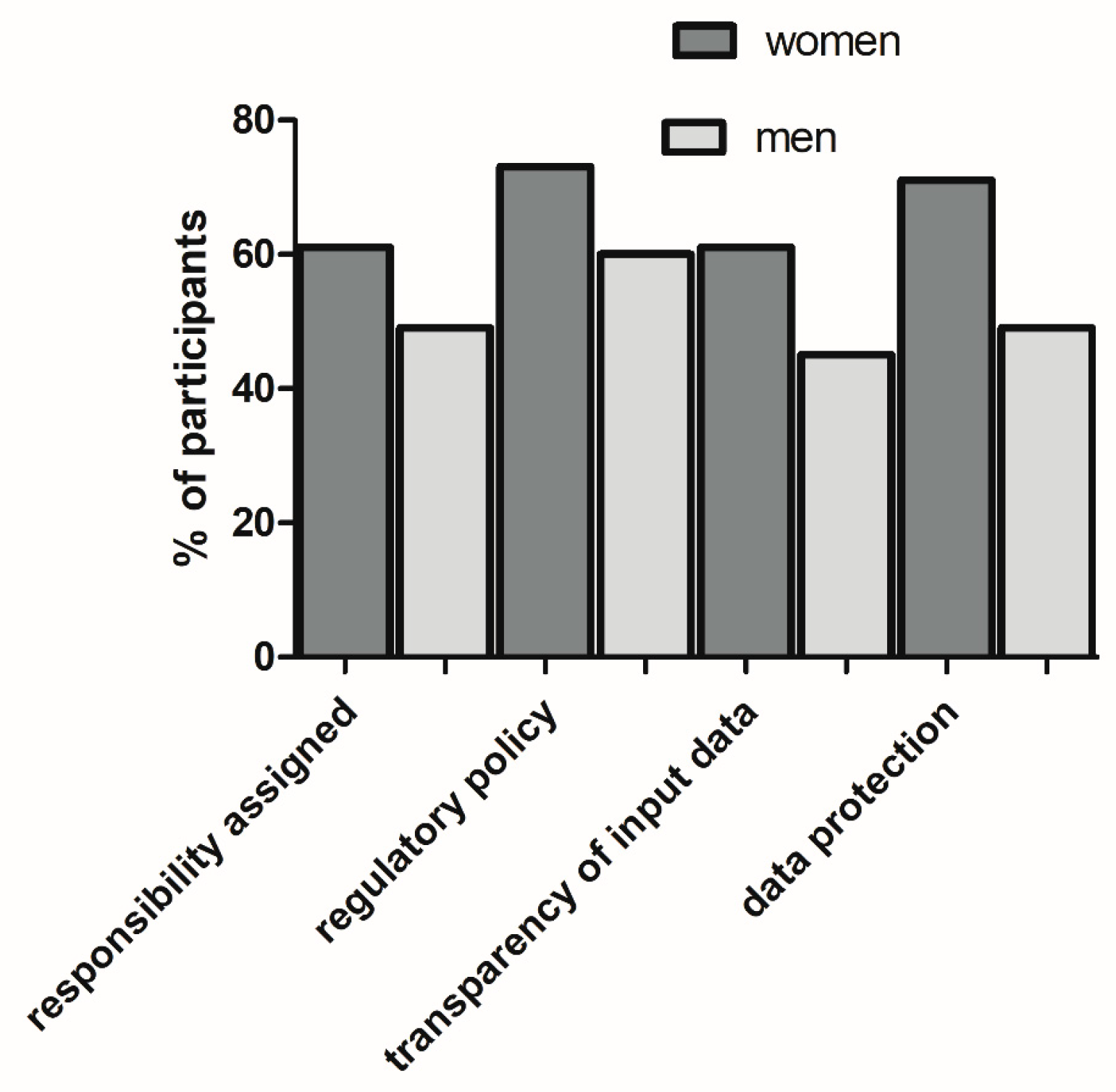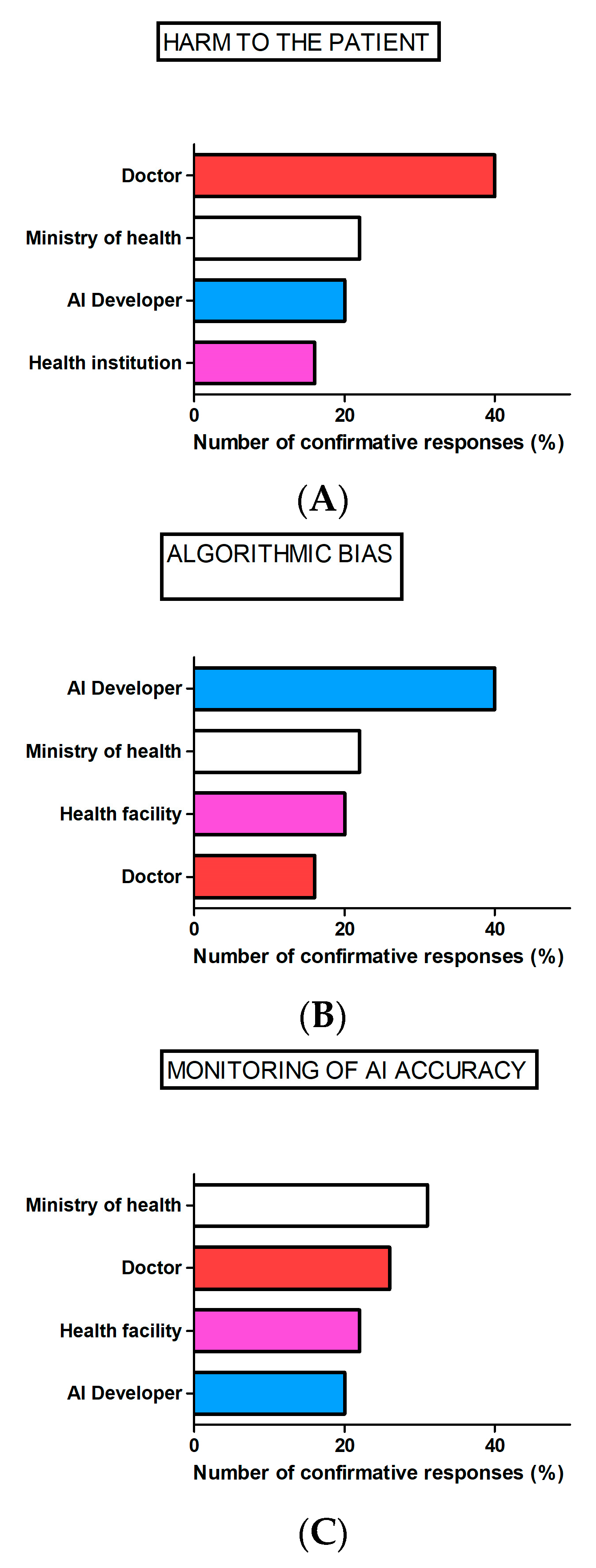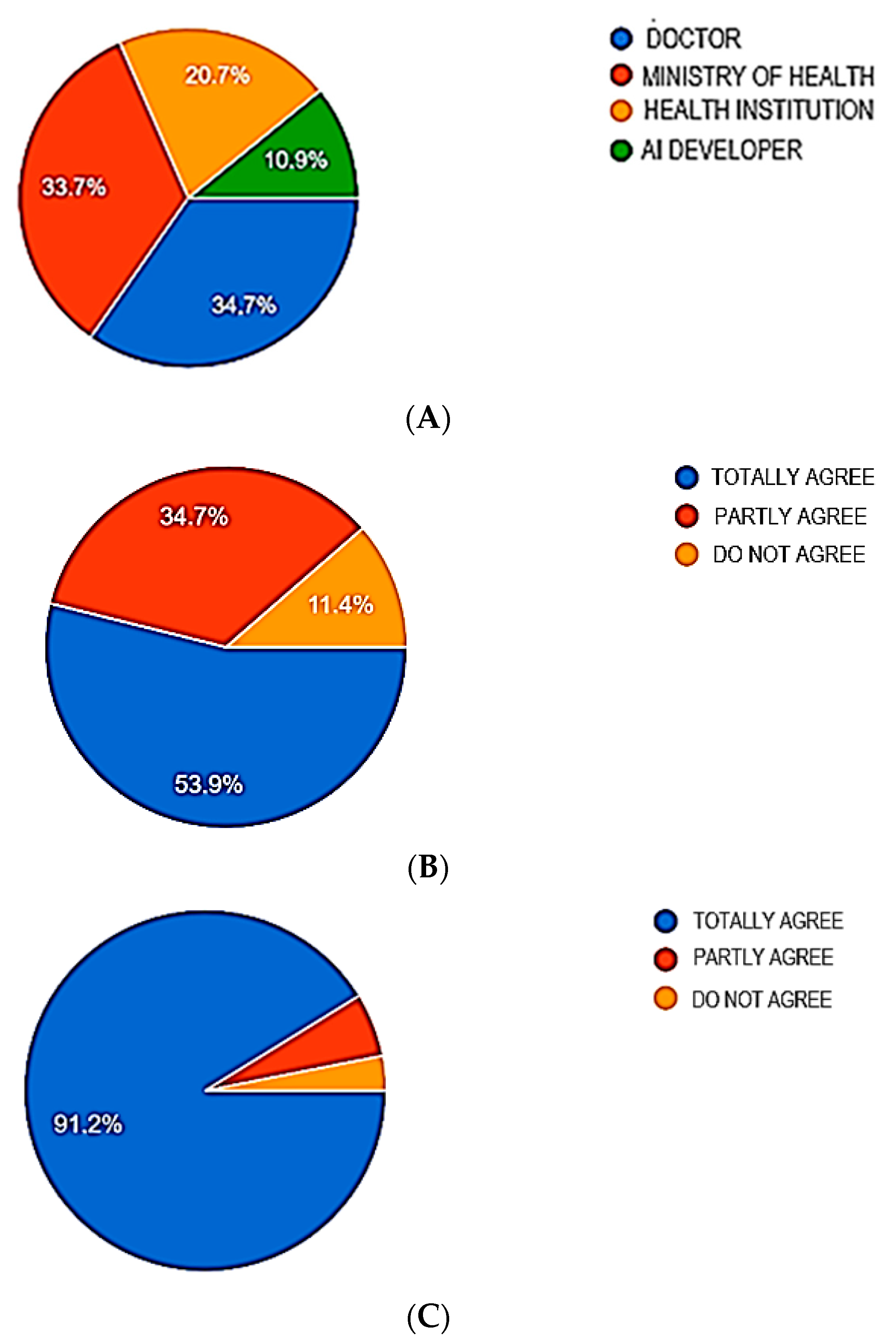Responsible Use of Artificial Intelligence in Dentistry: Survey on Dentists’ and Final-Year Undergraduates’ Perspectives
Abstract
1. Introduction
2. Materials and Methods
3. Results
3.1. Participants
3.2. Previous Experience with and Attitudes toward AI Use
4. Discussion
4.1. Dentist Qualification
4.2. Prudent Use of AI in Dentistry
4.2.1. Regulatory Policy Should Consider AI Use and Accountability if Harm to the Patient Occurs
4.2.2. Performance of AI across Representative Populations and How to Avoid Algorithmic Bias
4.2.3. Bias in Professional Judgment Due to Conflict of Interest
4.2.4. Data Management Control
- -
- using legitimately approved and regulated AI software;
- -
- engaging in obligatory education and training in AI use and the continuous monitoring of AI-based system performance in the particular group of patients;
- -
- protecting patients and implementing vigorous data management control;
- -
- extensively informing patients if there is any possibility that the AI system is being used for reasons other than to improve patient health, such as when a dentist or health facility has a conflict of interest.
5. Conclusions
Supplementary Materials
Author Contributions
Funding
Institutional Review Board Statement
Informed Consent Statement
Data Availability Statement
Acknowledgments
Conflicts of Interest
References
- Amato, F.; López, A.; Peña-Méndez, E.M.; Vaňhara, P.; Hampl, A.; Havel, J. Artificial Neural Networks in Medical Diagnosis. J. Appl. Biomed. 2013, 11, 47–58. [Google Scholar] [CrossRef]
- Bennett, C.C.; Hauser, K. Artificial Intelligence Framework for Simulating Clinical Decision-Making: A Markov Decision Process Approach. Artif. Intell. Med. 2013, 57, 9–19. [Google Scholar] [CrossRef] [PubMed]
- Cervino, G.; Cicciu, M.; Fiorillo, L.; Finocchio, G. Clinical Applications of the Algorithm “Pipeline Advanced Contrast Enhancement (Pace)” in Dental Radiology. Eng. Proc. 2023, 31, 10. [Google Scholar] [CrossRef]
- Price, W.N.; Gerke, S.; Cohen, I.G. Potential Liability for Physicians Using Artificial Intelligence. JAMA 2019, 322, 1765. [Google Scholar] [CrossRef] [PubMed]
- Parikh, R.B.; Teeple, S.; Navathe, A.S. Addressing Bias in Artificial Intelligence in Health Care. JAMA 2019, 322, 2377. [Google Scholar] [CrossRef]
- Briganti, G.; Le Moine, O. Artificial Intelligence in Medicine: Today and Tomorrow. Front. Med. 2020, 7, 27. [Google Scholar] [CrossRef]
- Gomes, R.F.T.; Schmith, J.; Figueiredo, R.M.d.; Freitas, S.A.; Machado, G.N.; Romanini, J.; Carrard, V.C. Use of Artificial Intelligence in the Classification of Elementary Oral Lesions from Clinical Images. Int. J. Environ. Res. Public Health 2023, 20, 3894. [Google Scholar] [CrossRef]
- Thurzo, A.; Strunga, M.; Urban, R.; Surovková, J.; Afrashtehfar, K.I. Impact of Artificial Intelligence on Dental Education: A Review and Guide for Curriculum Update. Educ. Sci. 2023, 13, 150. [Google Scholar] [CrossRef]
- Monterubbianesi, R.; Tosco, V.; Vitiello, F.; Orilisi, G.; Fraccastoro, F.; Putignano, A.; Orsini, G. Augmented, Virtual and Mixed Reality in Dentistry: A Narrative Review on the Existing Platforms and Future Challenges. Appl. Sci. 2022, 12, 877. [Google Scholar] [CrossRef]
- Kooli, C. Chatbots in Education and Research: A Critical Examination of Ethical Implications and Solutions. Sustainability 2023, 15, 5614. [Google Scholar] [CrossRef]
- Real, A.D.; Real, O.D.; Sardina, S.; Oyonarte, R. Use of Automated Artificial Intelligence to Predict the Need for Orthodontic Extractions. Korean J. Orthod. 2022, 52, 102–111. [Google Scholar] [CrossRef]
- Peck, S. Extractions, Retention and Stability: The Search for Orthodontic Truth. Eur. J. Orthod. 2017, 39, 109–115. [Google Scholar] [CrossRef]
- Parasidis, E. Clinical decision support: Elements of a sensible legal framework. J. Health Care Law Pol. 2018, 20, 183–228. [Google Scholar]
- Maliha, G.; Gerke, S.; Cohen, I.G.; Parikh, R.B. Artificial Intelligence and Liability in Medicine: Balancing Safety and Innovation. Milbank Q. 2021, 99, 629–647. [Google Scholar] [CrossRef]
- Verghese, A.; Shah, N.H.; Harrington, R.A. What This Computer Needs Is a Physician: Humanism and Artificial Intelligence. JAMA 2018, 319, 19. [Google Scholar] [CrossRef]
- Oppenheim, A.N. Questionnaire Design, Interviewing and Attitude Measurement; Continuum International Publishing Group Ltd.: London, UK, 1992; pp. 26–119. [Google Scholar]
- dos Santos, D.P.; Giese, D.; Brodehl, S.; Chon, S.H.; Staab, W.; Kleinert, R.; Maintz, D.; Baeßler, B. Medical Students’ Attitude towards Artificial Intelligence: A Multicentre Survey. Eur. Radiol. 2019, 29, 1640–1646. [Google Scholar] [CrossRef]
- Jacoby, J.; Matell, M.S. Three-Point Likert Scales Are Good Enough. J. Mark. Res. 1971, 8, 495–500. [Google Scholar] [CrossRef]
- Zheng, B.; Wu, M.N.; Zhu, S.J.; Zhou, H.X.; Hao, X.L.; Fei, F.Q.; Jia, Y.; Wu, J.; Yang, W.H.; Pan, X.P. Attitudes of medical workers in China toward artificial intelligence in ophthalmology: A comparative survey. BMC Health Serv. Res. 2021, 21, 1067. [Google Scholar] [CrossRef]
- Eschert, T.; Schwendicke, F.; Krois, J.; Bohner, L.; Vinayahalingam, S.; Hanisch, M. A Survey on the Use of Artificial Intelligence by Clinicians in Dentistry and Oral and Maxillofacial Surgery. Medicina 2022, 58, 1059. [Google Scholar] [CrossRef]
- Yüzbaşıoğlu, E. Attitudes and perceptions of dental students towards artificial intelligence. J. Dent. Educ. 2021, 85, 60–68. [Google Scholar] [CrossRef]
- Shah, N.R. Health Care in 2030: Will Artificial Intelligence Replace Physicians? Ann. Intern. Med. 2019, 170, 407. [Google Scholar] [CrossRef] [PubMed]
- Luxton, D.D. Recommendations for the Ethical Use and Design of Artificial Intelligent Care Providers. Artif. Intell. Med. 2014, 62, 1–10. [Google Scholar] [CrossRef] [PubMed]
- Benetti-McQuoid, J.; Bursik, K. Individual Differences in Experiences of and Responses to Guilt and Shame: Examining the Lenses of Gender and Gender Role. Sex Roles 2005, 53, 133–142. [Google Scholar] [CrossRef]
- Ward, S.J.; King, L.A. Gender Differences in Emotion Explain Women’s Lower Immoral Intentions and Harsher Moral Condemnation. Pers. Soc. Psychol. Bull. 2018, 44, 653–669. [Google Scholar] [CrossRef]
- Fatima, A.; Shafi, I.; Afzal, H.; Díez, I.D.L.T.; Lourdes, D.R.-S.M.; Breñosa, J.; Espinosa, J.C.M.; Ashraf, I. Advancements in Dentistry with Artificial Intelligence: Current Clinical Applications and Future Perspectives. Healthcare 2022, 10, 2188. [Google Scholar] [CrossRef]
- Ethical Dimensions of Using Artificial Intelligence in Health Care. AMA J. Ethics 2019, 21, E121–E124. [CrossRef]
- FDA, U.S.; Food and Drug Administration. Artificial Intelligence and Machine Learning (AI/ML)-Enabled Medical Devices. 2022. Available online: https://www.fda.gov/medical-devices/software-medical-device-samd/artificial-intelligence-and-machine-learning-aiml-enabled-medical-devices (accessed on 13 January 2023).
- Wu, E.; Wu, K.; Daneshjou, R.; Ouyang, D.; Ho, D.E.; Zou, J. How Medical AI Devices Are Evaluated: Limitations and Recommendations from an Analysis of FDA Approvals. Nat. Med. 2021, 27, 582–584. [Google Scholar] [CrossRef]
- Lee, J.J.; Ramirez, S.G.; Will, M.J. Gender and Racial Variations in Cephalometric Analysis. Otolaryngol. Head Neck Surg. 1997, 117, 326–329. [Google Scholar] [CrossRef]
- Muth, C.C. Conflict of Interest in Medicine. JAMA 2017, 317, 1812. [Google Scholar] [CrossRef]
- Dickens, B.M.; Cook, R.J. Conflict of Interest: Legal and Ethical Aspects. Int. J. Gynecol. Obstet. 2006, 92, 192–197. [Google Scholar] [CrossRef]
- Regulation (EU) 2016/679 of the European Parliament and of the Council of 27 April 2016 on the protection of natural persons with regard to the processing of personal data and on the free movement of such data, and repealing Directive 95/46/EC (General Data Protection Regulation). Off. J. Eur. Union Legis. Ser. 2016, 119, 1–88.



| Characteristic | Participants, Number (Percentage) |
|---|---|
| Age group (year) | |
| <30 | 96 (49.7%) |
| 30–45 | 57 (29.5%) |
| >45 | 40 (20.7%) |
| Gender | |
| Male | 55 (28.5%) |
| Female | 138 (71.5%) |
| Work experience (years) | |
| Student | 76 (39.4%) |
| <10 | 56 (29.0%) |
| >10 | 61 (31.6%) |
| Postgraduate degree | |
| PhD | 39 (20.4%) |
| Specialization | 61 (32.3%) |
| none | 94 (48.7%) |
| QUESTION—ATTITUDES | ANSWER—YES (Number) | ANSWER—PARTLY (Number) | ANSWER—NO (Number) |
|---|---|---|---|
| ARE YOU FAMILIAR WITH THE AI APPLICATIONS USE IN HEALTH CARE? | 28 (14.6%) | 112 (58.3%) | 52 (27.1%) |
| DO YOU USE OR FAMILIAR WITH USAGE OF CURRENT APPLICATIONS OF AI-BASED DENTAL SOFTWARE (ORCA Dental AI, Denti AI, VideaHealth, Pearl, Glidewell.io, Smilecloud, DentalXrai Pro, Dental Analytics, Dental monitoring, AssistDent etc.)? | 21 (10.9%) | 83 (43.0%) | 89 (46.1%) |
| DO YOU THINK AI COULD REPLACE DENTISTS IN A DENTAL PRACTICE? | 7 (3.6%) | 62 (32.3%) | 123 (64.1%) |
| DO YOU THINK AI COULD IMPROVE THE QUALITY OF DENTAL WORK IN A DENTAL PRACTICE? | 99 (51.3%) | 78 (40.4%) | 16 (8.3%) |
| DO YOU THINK AI COULD IMPROVE THE EFFICACY OF DENTISTS IN A DENTAL PRACTICE? | 110 (57.3%) | 70 (36.5%) | 12 (6.2%) |
| DO YOU THINK AI SHOULD BE USED IN A DENTAL PRACTICE? | 93 (48.7%) | 86 (45.0%) | 12 (6.3%) |
| AI APPLICATIONS IN DENTISTRY SHOULD BE INCORPORATED IN UNDERGRADUATE DENTAL CURRICULA? | 88 (45.8%) | 77 (40.1%) | 27 (14.1%) |
| AI APPLICATIONS IN DENTISTRY SHOULD BE INCORPORATED IN POSTGRADUATE DENTAL CURRICULA? | 130 (68.1%) | 51 (26.7%) | 10 (5.2%) |
| QUESTION—PERSPECTIVES | ANSWER—VERY SIGNIFICANT | ANSWER—SIGNIFICANT | ANSWER—NON-SIGNIFICANT |
| HOW DO YOU ESTIMATE THE SIGNIFICANCE OF THE FOLLOWING ETHICAL ISSUE: The lack of assigned responsibility for consequences of AI-based decision | 112 (58.0%) | 72 (37.3%) | 9 (4.7%) |
| HOW DO YOU ESTIMATE THE SIGNIFICANCE OF THE FOLLOWING ETHICAL ISSUE: The lack of transparent and representative data used for AI software development | 110 (57.0%) | 72 (37.3%) | 11 (5.7%) |
| HOW DO YOU ESTIMATE THE SIGNIFICANCE OF THE FOLLOWING ETHICAL ISSUE: The lack of regulatory policy which governs AI use | 134 (69.4%) | 52 (26.9%) | 7 (3.7%) |
| HOW DO YOU ESTIMATE THE SIGNIFICANCE OF THE FOLLOWING ETHICAL ISSUE: The data protection and privacy issues associated with AI use not specified | 125 (64.8%) | 58 (30.1%) | 10 (5.1%) |
| ATITUDES AND PERSPECTIVES | Significant Association with | Exp (B) | 95%CI | p-Value |
|---|---|---|---|---|
| ARE YOU FAMILIAR WITH THE AI APPLICATIONS USE IN HEALTH CARE? | Being student Holding PhD Having dental specialization | 0.575 6.671 2.431 | 0.35–0.92 3.21–13.86 1.43–4.12 | p = 0.023 p < 0.001 p < 0.001 |
| DO YOU USE OR FAMILIAR WITH USAGE OF CURRENT APPLICATIONS OF AI-BASED DENTAL SOFTWARE? | Holding PhD Having dental specialization | 3.598 1.794 | 2.03–6.34 1.13–2.85 | p < 0.001 p = 0.013 |
| DO YOU THINK AI COULD REPLACE DENTISTS IN A DENTAL PRACTICE? | Being student | 1.763 | 1.04–2.96 | p = 0.033 |
| DO YOU THINK AI SHOULD BE USED IN A DENTAL PRACTICE? | Being student | 0.518 | 0.31–0.84 | p = 0.009 |
| HOW DO YOU ESTIMATE THE SIGNIFICANCE OF THE FOLLOWING ETHICAL ISSUE: The lack of assigned accountability for consequences of AI-based decision | Being female | 0.554 | 0.32–0.93 | p = 0.027 |
| HOW DO YOU ESTIMATE THE SIGNIFICANCE OF THE FOLLOWING ETHICAL ISSUE: The lack of transparent and representative data used for AI software development | Being female | 0.506 | 0.30–0.84 | p = 0.009 |
| HOW DO YOU ESTIMATE THE SIGNIFICANCE OF THE FOLLOWING ETHICAL ISSUE: The lack of regulatory policy which governs AI use | Being female Being student | 0.446 1.743 | 0.25–0.77 0.98–3.09 | p = 0.004 p = 0.047 |
| HOW DO YOU ESTIMATE THE SIGNIFICANCE OF THE FOLLOWING ETHICAL ISSUE: The data protection and privacy issues associated with AI use not specified | Being female | 0.384 | 0.22–0.65 | p < 0.001 |
| WHO SHOULD BE ACCOUNTABLE FOR FALSE AI-BASED DECISION DUE TO ALGORITHMIC BIAS? | Being female | 0.715 | 0.53–0.95 | p = 0.02 |
| ATITUDES | Significantly Associated with (Predictor) | Exp (B) | 95%CI | p Value |
|---|---|---|---|---|
| ARE YOU FAMILIAR WITH THE AI APPLICATIONS USE IN HEALTH CARE? | Being student | 0.556 | 0.34–0.98 | p = 0.03 |
| DO YOU THINK AI COULD REPLACE DENTISTS IN A DENTAL PRACTICE? | Being student | 1.913 | 1.06–3.46 | p = 0.03 |
| DO YOU THINK AI SHOULD BE USED IN A DENTAL PRACTICE? | Being student | 0.510 | 0.29–0.87 | p = 0.01 |
| ARE YOU FAMILIAR WITH THE AI APPLICATIONS USE IN HEALTH CARE? | Holding PhD | 5.49 | 2.32–13.02 | p < 0.001 |
Disclaimer/Publisher’s Note: The statements, opinions and data contained in all publications are solely those of the individual author(s) and contributor(s) and not of MDPI and/or the editor(s). MDPI and/or the editor(s) disclaim responsibility for any injury to people or property resulting from any ideas, methods, instructions or products referred to in the content. |
© 2023 by the authors. Licensee MDPI, Basel, Switzerland. This article is an open access article distributed under the terms and conditions of the Creative Commons Attribution (CC BY) license (https://creativecommons.org/licenses/by/4.0/).
Share and Cite
Roganović, J.; Radenković, M.; Miličić, B. Responsible Use of Artificial Intelligence in Dentistry: Survey on Dentists’ and Final-Year Undergraduates’ Perspectives. Healthcare 2023, 11, 1480. https://doi.org/10.3390/healthcare11101480
Roganović J, Radenković M, Miličić B. Responsible Use of Artificial Intelligence in Dentistry: Survey on Dentists’ and Final-Year Undergraduates’ Perspectives. Healthcare. 2023; 11(10):1480. https://doi.org/10.3390/healthcare11101480
Chicago/Turabian StyleRoganović, Jelena, Miroslav Radenković, and Biljana Miličić. 2023. "Responsible Use of Artificial Intelligence in Dentistry: Survey on Dentists’ and Final-Year Undergraduates’ Perspectives" Healthcare 11, no. 10: 1480. https://doi.org/10.3390/healthcare11101480
APA StyleRoganović, J., Radenković, M., & Miličić, B. (2023). Responsible Use of Artificial Intelligence in Dentistry: Survey on Dentists’ and Final-Year Undergraduates’ Perspectives. Healthcare, 11(10), 1480. https://doi.org/10.3390/healthcare11101480







